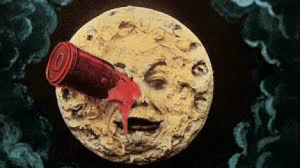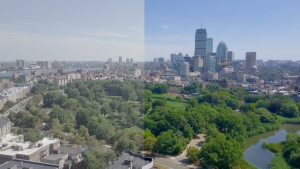Consumers are exposed to dozens of online videos every day, making the competition to stand out fierce. But what’s the “it” factor that sets apart amazing video content from mediocre video content? Color correction.

Everything from storytelling, cinematography, production design, and editing are all key elements to producing a great video. However, color correction is an often-overlooked step. Color correction isn’t a new idea; it started way before consumers were swimming in a sea of digital video content. Visually stunning videos owe it to filmmaker George Melies for popularizing color correction in the early 1900s.
When cameras were only capable of shooting black and white, director George Melies felt limited in his storytelling. He was one of the first filmmakers to add color to black and white film during post-production. He hired Elisabeth Thuillier (a painter) to add color to his film, and she, along with her studio of over 200 people, hand painted film stock frame by frame to add color. As a result, George became famous for his highly stylized films and innovative use of color. George Melies’s most famous film, A Trip to the Moon, played a big part in pioneering modern color correction and grading.

Today, color correction and grading can be completed digitally by one person instead of by a team of painters, which allows even novice editors to improve their video content simply by learning the basics of color correction and grading.
What’s the difference between color correction and color grading?
Color correcting is the process of adjusting the exposure, white balance, ISO noise, and contrast of an image to fix mistakes in the camera settings and enhance information from flat profiles. Basically, you are digitally altering the raw footage to match how the human eye perceives it. With color correction, the goal is to create a uniformed look for your footage that’s also aesthetically pleasing for viewers.
Once the footage has been corrected, the next step in the process is color grading. Now that you’ve adjusted the technical aspects of the footage, you can be creative and play with the look. Matching the color between different shots, changing the color of one specific part of the image, or enhancing the specific tones to pop on screen are all part of the color grading process. These adjustments result in a more stylized look that sets the mood and tone of your video.

Why Color Correction Matters
Color correcting videos isn’t useful for large film studios alone; it’s the new standard for online video content. With technology advancements and visual dependent platforms like Instagram, Snapchat, and YouTube, people expect high-quality visuals. Hitting record on your webcam doesn’t cut it anymore–brands, digital creators, and even vloggers are stepping up their video content game, and color correcting is one of the ways they are doing it. Here are a few reasons why color correction and color grading make your video content more dynamic and professional.
Get the Most Out of Your Footage
No matter how fancy your camera is or how skilled your cinematographer is, color correcting and grading is the best way to get the highest quality image. Many digital cameras have the option to shoot in a RAW camera format, which captures the flattest possible color spectrum. The color may look dull while you are filming, but RAW footage enables you to further manipulate the image in post-production. Considering all of the variables that change over the course of the day when filming, such as weather and lighting, choosing to turn off in-camera artificial enhancements and shooting flat footage ensures that you’ll have the greatest ability to adjust the image later. This allows editors to match camera shots to each other and create something that will capture an audience’s attention.

Increased Production Value
Color correction is an inexpensive way to increase the production value of all your content. As digital content creators, we all have to find ways to increase the production value without increasing the budget. In fact, our favorite color correction software to use, DaVinci Resolve by Blackmagic Designs, is free to download. Strong color correction and grading help separate professional content creators from amateurs. Your audience already associates color-corrected footage with professional level work, even if they don’t realize it. As media consumers, we are so accustomed to seeing highly stylized footage in TV shows and films that anything else looks amateur by comparison. It’s a big reason why your cell phone videos don’t look like Star Wars.
Storytelling
We all strive to create content that is engaging and concise. Color grading is another tool you can utilize to tell your brand’s story. Color will resonate emotionally with your audience because colors subconsciously generate moods. Emphasizing bright colors in the footage can create an upbeat and happy mood, while making dark, muted tones the focus will set a more serious and bleak tone.
You don’t have to commit to a super-stylized look because even a subtle color grade will help drive your message home. Additionally, if you’re a brand that puts out video content regularly, you can develop unique color looks that you use across all your content. The color in your digital video content is just as much a part of your brand identity as the color of your logo.
While more complicated than slapping an Instagram filter on an iPhone video or making everything sepia, the results are infinitely better! It’s an extra step in your post-production workflow but the time investment will pay off when you see an increase in the number of viewers on your online videos. Color is emotion. It’s a language we use to tell stories. The color of your videos helps keep your audience engaged. And an engaged audience will help your bottom line.
